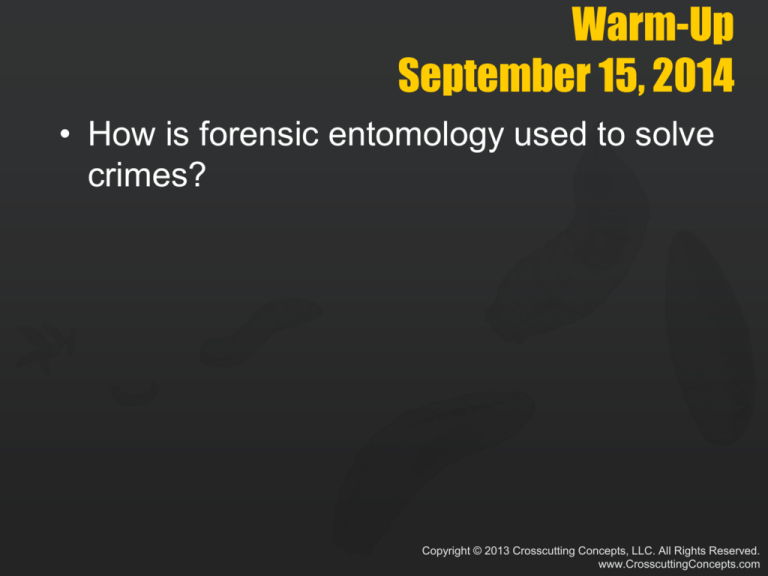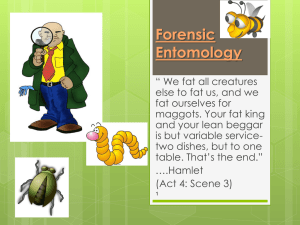
Warm-Up
September 15, 2014
• How is forensic entomology used to solve
crimes?
Copyright © 2013 Crosscutting Concepts, LLC. All Rights Reserved.
www.CrosscuttingConcepts.com
Objective
• SWBAT estimate the time of death using
entomology.
Copyright © 2013 Crosscutting Concepts, LLC. All Rights Reserved.
www.CrosscuttingConcepts.com
Agenda
1.
2.
3.
4.
5.
6.
Crime 360
Life Cycle of Fly
PMI/Time of Death
Real CSI Video
Crime Solving Insects
Exit Slip
Copyright © 2013 Crosscutting Concepts, LLC. All Rights Reserved.
www.CrosscuttingConcepts.com
Crime 360
Forensic Entomology
T. Trimpe 2008 http://sciencespot.net/
Watch the video and then answer the questions.
1. What does a forensic entomologist study?
A. Worms
B. Insects
C. Spiders
2. Fill in the missing information in this statement:
An entomologist needs to know the type of fly ____________ and the _________ of
the larva in order to help the investigators.
3. How can a blowfly help an investigation?
A. Helps investigators determine the time of death
B. Helps investigators determine how a person was killed
C. Helps investigators determine what the person ate at his/her last meal
4. What stage of a fly’s life cycle are maggots?
A. Adult
B. Pupa
C. Larva
5. In what kingdom are maggots classified?
A. Plants
B. Animals
C. Fungi
The answers are …
1. What does a forensic entomologist study?
A. Worms
B. Insects
C. Spiders
2. Fill in the missing information in this statement:
species
An entomologist needs to know the type of fly ____________
and the
age
_________
of the larva in order to help the investigators.
3. How can a blowfly help an investigation?
A. Helps investigators determine the time of death
B. Helps investigators determine how a person was killed
C. Helps investigators determine what the person ate at his/her last meal
4. What stage of a fly’s life cycle are maggots?
A. Adult
B. Pupa
C. Larva
5. In what kingdom are maggots classified?
A. Plants
B. Animals
C. Fungi
Carrion Flies
Many organisms use “carrion”, or
carcasses, as a food source. Some fly
species specialize in living on carrion.
These carrion flies are the most important
insects to the forensic entomologist.
Copyright © 2013 Crosscutting Concepts, LLC. All Rights Reserved.
www.CrosscuttingConcepts.com
Carrion Fly Families
There are two families of carrion flies: the
blowflies, in the family Calliphoridae, and
the flesh flies, in the family Sarcophagidae.
Adult calliphorid flies are easily identified by
their iridescent blue, green, copper, or black
bodies. Sarcophagid flies, on the other
hand, are grayish, usually with three distinct
longitudinal dark stripes on the dorsal
thorax.
Copyright © 2013 Crosscutting Concepts, LLC. All Rights Reserved.
www.CrosscuttingConcepts.com
Fly life cycle
adult
egg
The adult female
fly lays her eggs
on the exposed
tissue within
minutes of death.
She lays all eggs
in one sitting, but
may return to the
same site to lay
again several
times over the
course of her 2-3
week lifespan.
Copyright © 2013 Crosscutting Concepts, LLC. All Rights Reserved.
www.CrosscuttingConcepts.com
Fly life cycle
adult
egg
1st instar
The eggs hatch
within
approximately 24
hours of being
laid.
Fly larvae, known
as maggots, are
now in the first
instar stage.
They crawl to the
closest food
source and begin
to eat.
Copyright © 2013 Crosscutting Concepts, LLC. All Rights Reserved.
www.CrosscuttingConcepts.com
Fly life cycle
adult
egg
1st instar
The first instar
maggots are
small and do little
more than eat to
support their
rapid growth.
Over the next 27
hours, they will
double in size
until their skin
literally can’t hold
them anymore.
Copyright © 2013 Crosscutting Concepts, LLC. All Rights Reserved.
www.CrosscuttingConcepts.com
Fly life cycle
adult
egg
1st instar
2nd instar
The maggots
shed their old
skin and are now
considered
second instar
maggots.
This stage is very
similar to the first
instar in that the
maggots
continue to
devour their food
source and grow
rapidly.
Copyright © 2013 Crosscutting Concepts, LLC. All Rights Reserved.
www.CrosscuttingConcepts.com
Fly life cycle
adult
egg
1st instar
3rd instar (feed)
2nd instar
After another 22
hours, these
maggots will
have reached
the maximum
size their
current skin will
allow and they
will shed once
more.
They are now in
their third
instar
Copyright © 2013 Crosscutting Concepts, LLC. All Rights Reserved.
www.CrosscuttingConcepts.com
Fly life cycle
The third instar
stage is divided
into two halves,
the feeding third
instar and the
migrating third
instar
adult
egg
1st instar
3rd instar (feed)
2nd instar
During the first
half, the maggots
continue to eat,
storing up as
much energy as
possible.
Copyright © 2013 Crosscutting Concepts, LLC. All Rights Reserved.
www.CrosscuttingConcepts.com
Fly life cycle
egg
The second half of the
third instar begins
when the maggots
stop eating and begin
to move away from
their food source.
1st instar
The maggots will move
to a patch of soil
where they can burrow
and begin the next life
stage.
adult
3rd instar
2nd instar
Overall, the maggots
spend about 100 hours
in their third instar.
Copyright © 2013 Crosscutting Concepts, LLC. All Rights Reserved.
www.CrosscuttingConcepts.com
Fly life cycle
adult
egg
Pupae
1st instar
3rd instar
Once burrowed, the
maggots enclose
themselves in a hard
shell and begin the
metamorphosis
(change) that will
result in an adult fly.
At this stage, the
maggots are now
known as pupae.
2nd instar
Copyright © 2013 Crosscutting Concepts, LLC. All Rights Reserved.
www.CrosscuttingConcepts.com
Did you know…
The “Body Farm” in Knoxville, Tennessee is a university
research facility to investigate human decomposition under
various conditions in order to understand the factors which
affect its rate.
Click the image to view a
video about the Body Farm!
The Post Mortem Interval
Forensic entomology provides data used to
estimate the time that elapsed between the
actual death and when the body was first
discovered.
This period is referred to as the post
mortem interval, or PMI.
Copyright © 2013 Crosscutting Concepts, LLC. All Rights Reserved.
www.CrosscuttingConcepts.com
The Post Mortem Interval
Recent PMI (0-50 hours) is estimated by a
medical examiner or forensic pathologist
based on physical changes to the cadaver.
If a body remains exposed to the
environment for a longer period of time, the
normal physical changes observed after
death may not provide an accurate PMI
estimate.
Copyright © 2013 Crosscutting Concepts, LLC. All Rights Reserved.
www.CrosscuttingConcepts.com
Body
Temperature
Rigor Mortis
Post-Mortem
Interval
Warm
Far extremities and
small muscles only
< 3 hours
Warm
Middle extremities
and medium
muscles
3 – 8 hours
Cold
Throughout body
Cold
None
8 – 36 hours
> 36 hours
Copyright © 2013 Crosscutting Concepts, LLC. All Rights Reserved.
www.CrosscuttingConcepts.com
The Post Mortem Interval
Cadavers decompose in four stages: fresh,
bloated, decay, and dry. The time the body
spends in any individual stage will vary
depending on environmental conditions;
warm, wet weather speeds decay, while
cold, dry weather slows it.
Copyright © 2013 Crosscutting Concepts, LLC. All Rights Reserved.
www.CrosscuttingConcepts.com
The Post Mortem Interval
Different insects are attracted to each of the
four different stages of decomposition. The
ordered series of insects attracted to the
decomposing body is called a succession.
The succession pattern is useful in
estimating how long a cadaver has been
exposed to the insects.
Copyright © 2013 Crosscutting Concepts, LLC. All Rights Reserved.
www.CrosscuttingConcepts.com
The Post Mortem Interval
For example, carrion flies are attracted to a
bloated corpse, therefore they will only be
present on a corpse once that stage is
reached.
Adult blowflies, however, are attracted to the
fresh corpse and lay their eggs rapidly after
death.
Copyright © 2013 Crosscutting Concepts, LLC. All Rights Reserved.
www.CrosscuttingConcepts.com
Factors influencing decay
Most important environment factors in corpse
decay:
• Temperature
• Access by insects
• Depth of burial
Other Factors
• Chemical-- embalming agent, insecticides,
lime, etc.
• Animals disrupting the corpse
Copyright © 2013 Crosscutting Concepts, LLC. All Rights Reserved.
www.CrosscuttingConcepts.com
Factors influencing decay
Entomologists develop and maintain
succession databases.
When a crime scene is investigated, the
forensic entomologist compares the insect
species and their distribution of larval
stages to the database to estimate the time
of death.
Copyright © 2013 Crosscutting Concepts, LLC. All Rights Reserved.
www.CrosscuttingConcepts.com
Degree-hours
The time it takes each life cycle to develop
is measured in degree-hours because the
development rate is VERY temperature
dependent.
If an egg takes 23 hours to develop into the
1st instar at 70˚F, then 1610 degree-hours
would have accumulated.
Copyright © 2013 Crosscutting Concepts, LLC. All Rights Reserved.
www.CrosscuttingConcepts.com
Calculating PMI from
Accumulated Degree Hours (ADH)
From
To
Temp
Hours
ADH
Total
Egg
1st Instar
70° F
23
1610
1610
1st Instar
2nd Instar
70° F
27
1890
3500
2nd Instar 3rd Instar
70° F
22
1540
5040
3rd Instar
Pupa
70° F
130
9100
14140
Pupa
Adult Fly
70° F
143
10010
24150
Copyright © 2013 Crosscutting Concepts, LLC. All Rights Reserved.
www.CrosscuttingConcepts.com
Time of Death vs PMI
Time of death and Post-Mortem Interval are
usually different because of the assumptions of
the PMI calculation.
PMI is restricted to the time that the corpse or
body has been exposed to an environment which
would allow insect activity to begin. This could be
affected by factors such as:
– Closed windows
– Body in box or bag
– Cold temperatures
– Deeper burial
Copyright © 2013 Crosscutting Concepts, LLC. All Rights Reserved.
www.CrosscuttingConcepts.com
Important Considerations
In addition to the succession of insects on the
decaying cadaver, there is a succession of
species of insects throughout the year, especially
in a temperate climate.
Some fly species are active in the early spring,
different species are active in the fall, and others
are continuously active.
Copyright © 2013 Crosscutting Concepts, LLC. All Rights Reserved.
www.CrosscuttingConcepts.com
Important Considerations
In regions with cold winters, bodies are often
discovered when the snow melts in the spring,
and investigators are called upon to determine in
which season the death occurred.
If an insect larvae which is more abundant in the
fall is discovered, this can indicate the body was
undiscovered for many months, while if larvae are
found from spring flies, this could indicate the
cadaver is more recent, or that it was recently
exposed to the newly emerged adult flies.
Copyright © 2013 Crosscutting Concepts, LLC. All Rights Reserved.
www.CrosscuttingConcepts.com
Real CSI Video
10. What is the most common type of gun?
11. If someone is shot and there are no
casings at the scene, then what type of
gun did they probably use?
12. What is range of fire?
13. What comes out of a fired handgun?
14. Why do ballistics labs test fire the
weapon into the water chamber?
Copyright © 2013 Crosscutting Concepts, LLC. All Rights Reserved.
www.CrosscuttingConcepts.com
What happened
to Porky?
Presentation developed for use with the Crime Solving Insects activity available at http://ipm.ncsu.edu/4-H/CSIfinal.pdf.
Image: http://www.animals-in-distress.net/files/photos/coriander2.jpg
T. Trimpe 2009 http://sciencespot.net/
Things to Remember …
• The progression of insect life follows a pattern, and the developmental rates of
flies are relatively predictable.
• The rate of insect development is influenced by temperature because insects are
ectothermic (“cold blooded”), which means their body temperatures are largely
dictated by the outside temperature. Only when the outside temperature warms an
insect’s internal body temperature to its critical level can the insect become active
(and eat and grow).
• The postmortem interval—the time between death and discovery of the corpse –
can be estimated using insect evidence and temperature data along with other factors,
such as the presence of drugs in a corpse and conditions related to the corpse itself
(wrapped in a material, in a closed room, exposed to outside conditions, etc.)
• Not all fly species are found everywhere, and this can provide important
information also. For example, the skipper fly, Piophila nigriceps (pie-oh-FEEL-ah
NYE-greh-cehps), is found only in urban settings. House flies, blow flies, and flesh
flies can be found in both urban and rural settings.
Metamorphosis
• Flies, beetles, and many other insects have complete metamorphosis, which
consists of four stages – egg, larva, pupa, and adult.
• After the adults mate, the females lay eggs onto corpses - usually near natural
body openings or wounds.
• Feeding activity is usually seen
in the head region first (mouth,
nostrils, eyes, ears), followed by
the excretory and reproductive
openings. The trunk of the body
is invaded much later in the
process.
• The length of the life cycle
varies between different fly
species and is dependent on
temperature.
http://www.cmnh.org/site/Img/ResearchandCollections/InvertZoo/124_blowflylifecycleRW.jpg
Stages of Decay
1 - Fresh Stage
• Begins at the moment of death and lasts until the body becomes bloated.
• Blow flies and flesh flies are among the first to find the body.
• Predatory wasps and beetles may arrive later to feed on the maggots (but not the corpse).
2 - Bloated Stage
• Begins when the body becomes inflated due to the production of gases from bacteria that
begin to putrefy the body or cause it to decompose.
• House flies now join the other flies and their maggots form feeding masses that help to
liquefy the tissues of the body.
3 - Decay Stage
• Begins when the skin breaks and the gases escape.
• Maggot masses are large and very active as they grow older and larger.
• This is the stage of decomposition that smells bad.
• At the end of this stage, the maggots leave the corpse in search of a place to pupate in the
soil.
4 – Post-Decay Stage
• Most of the flesh is gone from the corpse, with only cartilage, bone, and skin remaining.
• This stage is devoid of flies. Some beetles continue to feed on the highly desiccated or
dried remains.
Case Studies
For each case:
1 – Review the police report and weather report.
2 – Examine & document the collected evidence.
• Measure the length of the maggots & pupae. Record your data in a chart.
• Consult the Species Key and the tables on your lab page to determine the
various fly species that were found on the corpse and their ages.
3 – Use the information from the reports and your examination to
answer the questions.
Case #1: Oh, Deer!
Police Report: The body of a female deer was found behind a fence along a busy two-lane
road on the edge of the city limits of Charlotte. Animal Control was called and reported no
apparent wounds on the body. It was not hunting season.
Weather Report: Daytime temperatures have been fairly consistent for the past three weeks,
ranging from 70 to 74º F.
Questions:
1. Approximately how long has this animal been dead?
2. Why are maggots of different ages found in the body?
3. Other than temperature, what abiotic (external to the
corpse) conditions would you want to obtain from the
weather station to help you to be more confident of your
time of death estimation?
Species &
Stage
Size
(mm)
Age
Case #2: Canine Caper
Police Report: The body of a large pit bull terrier was found inside a walk-in basement at a
home in Cary. Maggots were found concentrated in the head and region behind the shoulder.
The windows were closed, although the open curtains allowed sunlight to enter, and the air
conditioner was set at 72º F.
Weather Report: Daytime temperatures have been variable over the past three weeks,
ranging from 75 to 94º F. Skies have been sunny.
Questions:
1. Approximately how long has this animal been dead?
Species &
Stage
Size
(mm)
2. What effect, if any, do the outside temperatures have
on your estimation of time of death in this case?
3. How does the fact that the windows were closed relate to the populations of flies you
observed in and around the corpse?
4. Do you suspect foul play? Explain.
Age
Case #3: Dandy’s Death
Police Report: The body of a young male horse was found in a pasture in a small town near
Wilmington. The autopsy from the vet school reveals that the cardiac glycoside, oleandrin (a
powerful heart stimulant), was present in the body. Oleandrin is found in the oleander plant.
Oleander is a common ornamental shrub in this area, but none grows within 200 feet of the
pasture.
Weather Report: Daytime temperatures have been unusually warm over the past three weeks,
ranging from 84 to 86º F.
Questions:
1. Approximately how long has this animal been dead?
Species &
Stage
Size
(mm)
Age
2. What effect, if any, does oleandrin have on your
estimation of time of death?
3. What effect, if any, does temperature have on your estimation of time of death in this case?
4. Do you suspect foul play? Explain.
Case #4: Porky’s Peril
Police Report: The body of a large pot-bellied pig was found in a dense stand of evergreen
trees far from any urban area in Buncombe County. Hairs around the pig’s neck were worn
away in a band pattern.
Weather Report: Daytime temperatures have been average over the past three weeks, ranging
from 70 to 73º F. Temperatures in the woods would be approximately 5 degrees cooler due to
the lack of sun in the shady environment.
Questions:
1. Approximately how long has this animal been dead?
2. What effect, if any, does temperature have on your
estimation of time of death in this case?
3. Do you suspect foul play? Explain.
Species &
Stage
Size
(mm)
Age
Homework
• Unit 2 Review due Tuesday
• UNIT 2 EXAM ON WEDNESDAY
Copyright © 2013 Crosscutting Concepts, LLC. All Rights Reserved.
www.CrosscuttingConcepts.com
Exit Slip
September 15, 2014
1. Get out a mobile device or use one of
the computers and go to
m.socrative.com. You can also use one
of the iPads that has the Socrative app.
2. When prompted, enter 417101 for the
room number.
QUESTION: How can you use
entomology to determine the time of a
person’s death?
Copyright © 2013 Crosscutting Concepts, LLC. All Rights Reserved.
www.CrosscuttingConcepts.com







